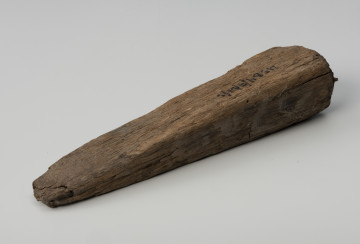
Long comb
1176 — 1225
National Museum in Szczecin
Part of the collection: Pyrzycka folk culture
A chest was popular furnishing of the country house from the 17th and in some areas of Poland from the 18th century. Traditionally it was part of a bride's dowry. The wealthy women owned several chests used to store clothing, bedding, towels, tablecloths, etc. The chests were made by specialised craftsmen - carpenters, who mainly sold at fairs and markets. They also made furniture to order, usually when it was to be a maiden dowry. Then the ornamentation was usually completed with the owner's name, a monogram, the date of marriage and occasionally a sentence. The presented chest is a typical piece of Pomeranian furniture. It has a knotted construction tied with the so-called tins, the walls are slightly tapering towards the bottom, it is supported on a profiled footstool, and the lid is convex. Inside there is a compartment, the so-called box, which was used to store small items: beads, ribbons, selvedges, a prayer book and sometimes documents. The painting of the chest with a strong contrast of cold colours in the background (in this case navy blue) and warm colours in the patterns (in this case red, green and white) is typical for the Pyrzyce region. Floral motifs are scattered over the entire surface of the chest, while the red inscription 'Anno 1858' and 'Marie Meier' are centrally placed. Another distinguishing feature of this chest is its size, which is a few centimetres above the average size. The difference can be seen above all in the height of 90 cm compared to the typical 58-68 cm.
Iwona Karwowska
Author / creator
Dimensions
cały obiekt: height: 90 cm, width: 128 cm
Creation time / dating
Creation / finding place
Identification number
Location / status

1176 — 1225
National Museum in Szczecin

1176 — 1200
National Museum in Szczecin

1101 — 1200
National Museum in Szczecin
DISCOVER this TOPIC
Museum of King Jan III's Palace at Wilanów
DISCOVER this PATH
Educational path